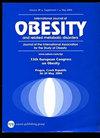Dietary patterns among European children and their association with adiposity-related outcomes: a multi-country study
IF 3.8
2区 医学
Q1 ENDOCRINOLOGY & METABOLISM
引用次数: 0
Abstract
Children’s diets in school-age are inherently unhealthy, with few meeting dietary recommendations. Yet, little is known about similarities and differences on dietary patterns across countries and their association with obesity. We aimed to derive dietary patterns in childhood and explore their association with adiposity-related outcomes in childhood and adolescence. This study included data from six European countries (Spain, France, UK, Greece, Lithuania and Norway) during childhood (n = 1597) and adolescence (n = 803). Using a food frequency questionnaire, we derived data-driven dietary patterns through exploratory factor analyses and calculated the Mediterranean KIDMED index. We assessed body mass index z-score (zBMI), fat mass proportion and waist-to-height ratio at both visits. Associations were estimated using generalized linear regressions, adjusted for key-confounders. “Meat”, “Dairy”, “Western”, “Healthy” and “Sweets and fats” dietary patterns were derived. Norwegian children showed better diet quality, with higher consumption of fruits and vegetables, and highest “Healthy pattern” adherence, and Lithuanian children, the worst, with higher sweets consumption, and highest “Western pattern” adherence. Children with lower intake of healthy foods (vegetables, fruits, fish) tended to have higher adiposity, e.g., children with average or low “Healthy pattern” adherence (vs. high) had higher fat mass proportion in childhood (average: β (95% CI) 1.44 (0.48; 2.39), low: 1.10 (0.09; 2.12)). Low adherence to a “Healthy pattern” (vs. high) was associated with increased adolescent zBMI, and child and adolescent waist-to-height ratio. Low “Dairy pattern” adherence (vs. high), was associated with lower zBMI and fat mass in childhood, but not in adolescence. No significant associations were seen with the KIDMED index. Many European children have poor diets and a low adherence to a healthy diet pattern may be of concern for adiposity-related outcomes. Assessment of children’s dietary patterns can help tailor dietary advice and provide support for families aiming to prevent future excess weight gain.

欧洲儿童的饮食模式及其与脂肪相关结果的关系:一项多国研究。
背景/目的:学龄儿童的饮食本身就不健康,很少有儿童的饮食符合膳食建议。然而,人们对各国膳食模式的异同及其与肥胖的关系知之甚少。我们的目的是得出儿童时期的饮食模式,并探讨其与儿童和青少年时期脂肪相关结果的联系:这项研究包括六个欧洲国家(西班牙、法国、英国、希腊、立陶宛和挪威)在儿童期(n = 1597)和青少年期(n = 803)的数据。我们使用食物频率问卷,通过探索性因素分析得出数据驱动的饮食模式,并计算出地中海 KIDMED 指数。我们在两次访问中都评估了体重指数 z 值(zBMI)、脂肪质量比例和腰围与身高的比率。我们使用广义线性回归对相关性进行了估计,并对关键因素进行了调整:结果:得出了 "肉类"、"乳制品"、"西式"、"健康 "和 "甜食与脂肪 "饮食模式。挪威儿童的饮食质量较好,水果和蔬菜摄入量较高,"健康饮食模式 "坚持率最高;立陶宛儿童的饮食质量最差,甜食摄入量较高,"西式饮食模式 "坚持率最高。摄入健康食品(蔬菜、水果、鱼类)较少的儿童往往脂肪含量较高,例如,"健康模式 "依从性一般或较低(与较高相比)的儿童在童年时脂肪质量比例较高(平均:β(95% CI)1.44(0.48;2.39),较低:1.10(0.09;2.12))。健康模式 "坚持率低(与坚持率高相比)与青少年 zBMI 以及儿童和青少年腰围与身高比率增加有关。乳制品模式 "坚持率低(与坚持率高相比)与儿童时期 zBMI 和脂肪量较低有关,但与青少年时期无关。与 KIDMED 指数没有明显关联:结论:许多欧洲儿童的饮食习惯不良,对健康饮食模式的依从性较低可能会导致与脂肪相关的结果。对儿童饮食模式的评估有助于为家庭量身定制饮食建议并提供支持,以防止未来体重增加过多。
本文章由计算机程序翻译,如有差异,请以英文原文为准。
求助全文
约1分钟内获得全文
求助全文
来源期刊

International Journal of Obesity
医学-内分泌学与代谢
CiteScore
10.00
自引率
2.00%
发文量
221
审稿时长
3 months
期刊介绍:
The International Journal of Obesity is a multi-disciplinary forum for research describing basic, clinical and applied studies in biochemistry, physiology, genetics and nutrition, molecular, metabolic, psychological and epidemiological aspects of obesity and related disorders.
We publish a range of content types including original research articles, technical reports, reviews, correspondence and brief communications that elaborate on significant advances in the field and cover topical issues.
 求助内容:
求助内容: 应助结果提醒方式:
应助结果提醒方式:


